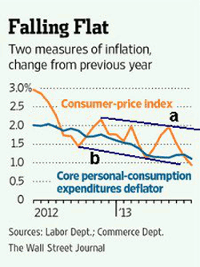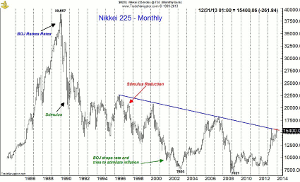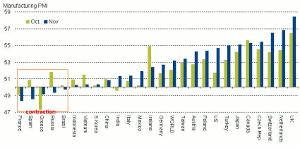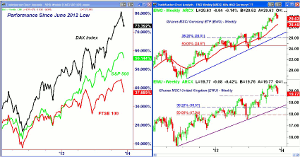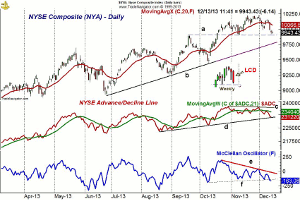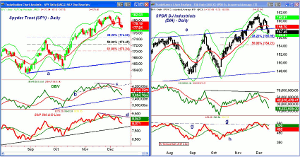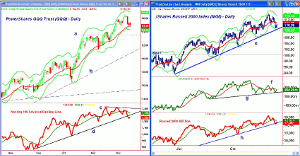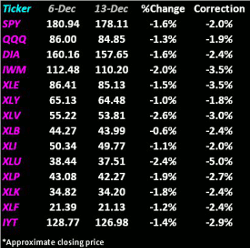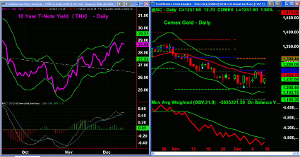As the financial media get ready for another round of obsessing over the results of this week's FOMC meeting, MoneyShow's Tom Aspray discusses whether the Fed has another reason not to act.
The stock market stabilized late last week but the damage was done by mid-week as the technical deterioration had given advance warning of the market’s decline. Last Monday’s feeble reaction to the powerful gains on the jobs report was disappointing and short-term sell signals were generated.
The financial media is attributing the stock market decline to the growing consensus that the Fed may announce changes in their bond buying program at the conclusion of this week’s FOMC meeting. Thus, the dreaded tapering is again the focus of many analysts.
In August, I explained my view that more taper tantrums would be bullish, and the stock market’s correction ended about two weeks later. Since then, the improvement in the unemployment numbers has convinced some that the Fed can now justify tapering.
Though it has not been widely discussed, it is my opinion that fear of deflation is likely to keep the Fed from changing its policy now. Last week’s Producer Price Index reflected almost no inflation at the producer level, and this Tuesday, we get the Consumer Price Index.
The WSJ chart shows that the CPI is in a solid downtrend as it shows lower highs and lower lows (lines a and b). The chart also includes what the Journal refers to as the Fed’s “preferred measure of prices, known as the personal-consumption expenditures deflator.” On a year-to-year basis, it reflected a rise of only 0.74% in October.
If the Fed waits until the inflation rate is high enough so they are no longer concerned about deflation, it could be several years before they start tapering. Though this is not grasped by many investors, market historians are only too aware of what happened in Japan.
The monthly chart of Japan’s Nikkei 225 goes back to the 1980’s and shows the reversal from the December 1989 high at 38,957 as the BOJ raised rates in an effort to stem the parabolic rise in real estate prices. As indicated on the chart, they started to realize that deflation might be a problem in 1990, but when the economy improved, they became nervous in 1997, causing another plunge in stock prices.
The NK225 made an initial low in May of 2003 as it was down 78.6% from the highs. A lower low at 7021 was made in early 2009. Though Japan’s bubble was not exactly like ours, it does demonstrate that a deflationary spiral is very difficult to overcome.
The US leaders made a similar misstep as the Japanese in 1937 when they cut off the stimulus too early and pushed the country back into a recession. I think we have learned our lesson and Ben Bernanke’s masterful job is likely to receive well-deserved accolades in the history books. I was disappointed last summer in the somewhat-shabby treatment he received from President Obama.
The plunge in gold prices has not given the deflationists much comfort as the SPDR Gold Trust (GLD) is down close to 27% YTD and continues to act weak. The bull trap I warned about in August slammed shut in November as the OBV led prices lower.
Overall, there has been significant improvement in the global economy this fall, and I would expect it to get much better in 2014, which will justify even higher stock prices. The budget accord should also help the stock market in 2014.
The Global Purchasing Manager data reflected sharp improvement in November, and many were surprised that the United Kingdom was the strongest, followed by the Netherlands and Switzerland. The Global Composite is well above 53 with contraction only evident in France, Spain, Greece, Russia, and Brazil.
Several money mangers have been touting Europe lately due to its lower P/E than the US. Though their analysis may turn out to be correct eventually, the technical action suggests that now is not the time to buy.
NEXT PAGE: What to Watch
|pagebreak|The German DAX Index has corrected more sharply that the US, so far in December, as it is down 8% from the late November highs. It is still leading the Spyder Trust (SPY) since June 2012 as it is up over 73% compared to the 56% gain in the Spyder Trust (SPY). The UK’s FTSE 100 is up just 37.7% during the same period.
The technical action suggests all three can correct further as the iShares MSCI Germany ETF (EWG) has closed lower for the past two weeks. It is up over 22% for the year, and at a minimum, should drop back to the rising 20-week EMA at $28.49. There is more important chart and Fibonacci retracement support in the $26-$27 area.
The iShares MSCI United Kingdom (EWU) is up just over 12% for the year according to Morningstar, which is one of my four favorite research sites. It closed the week just above next support at $19.76 with more important now in the $18.50-$19.00 area. Given the dramatic improvement in their economy, this correction should set up a good buying opportunity in early 2104.
The Retail Sales data last week beat expectations as we head into a very busy week for economic data though the focus will be on the FOMC meeting that concludes on Wednesday.
We should get a better reading on the manufacturing sector this week with the Empire State Manufacturing Survey, the flash PMI Manufacturing Index, and Industrial Production on Monday. The Philadelphia Fed Survey is due out on Thursday.
Many are also wondering about the strength of the housing rebound as the home construction stocks are well below the May highs, and they show no clear signs of bottoming yet. This week’s data may give us some more insight with the Housing Market Index out on Tuesday, Housing starts on Wednesday, and Existing Home Sales on Thursday.
Also on the economic front is the Consumer Price Index, Tuesday, with jobless claims, Thursday, and the latest reading on the GDP due out on Friday.
What to Watch
Last week, the divergences in the daily technical studies suggested a top was being formed. This was confirmed by Tuesday’s close so the sharp drop last Wednesday was not surprising. Despite this, there are still quite a few bargain-hunting money managers out there that are still trying to catch up with their benchmarks.
Therefore, a decent rebound is likely as the top is being completed, but it will have to be very impressive to indicate that the correction is already over. The weekly OBV is positive longer term suggesting that this is a correction and not the formation of a major top.
The NYSE Composite, Spyder Trust (SPY) and the SPDR Dow Industrials (DIA) will trigger weekly low close doji sell signals this week. It would take a move above the November highs to reverse these signals.
The number of S&P 500 stocks above their 50-day MA, has dropped further to 62 but it is still well above oversold levels. At the June and September lows, it dropped below 40. The small caps have been hit harder and the number of S&P 600 stocks above their 50-day MAs is at 52. At the last two lows, it dropped to 36.
The AAII sentiment bullish percentage is still quite high at 41.2% with the number of bears at 25.7% down a bit from 27.5% last week. The number of bullish financial newsletter writers continues to move higher, now at 58.2%, up from 37.1% at the early September lows. The bears were unchanged at 14.3%.
NEXT PAGE: Stocks
|pagebreak|The daily chart of the NSYSE Composite shows that prices are already close to the support from the September highs, line a. On a close below the November low of 9909, the next target is the minor 38.2% Fibonacci retracement support at 9734 and the uptrend, line b. The 50% support level stands at 9579, which is just above the quarterly pivot at 9558. Using current data, the 1st quarter pivot would be at 9878 with the S1 support at 9528.
The declining 20-day EMA at 10,066 represents first resistance with the job report high at 10,159. The weekly chart of the NYSE Composite (see insert) shows that a weekly low close doji sell signal was triggered with last Friday’s close.
The daily NYSE Advance/Decline formed lower highs in late November, which was a negative divergence, line c. The initial uptrend in the A/D line (line d) is now being tested. There is more important support at the June and August lows.
The weekly A/D line (not shown) will drop below its WMA this week but is still above major support. The McClellan oscillator formed a much more severe negative divergence since the October highs, line 3, and then dropped below two-month support at line f, last week.
The oscillator should close the week at around -160. As I mentioned in last week’s trading lesson where I combined the signals from the McClellan oscillator and the Total Put/Call ratio, the oscillator often reaches -300 before it bottoms out.
S&P 500
The Spyder Trust (SPY) closed the week near its daily starc- band with the monthly projected pivot support at $176.59. The next key support is at $174.76, which corresponds to the November lows. The weekly starc- band is just below the 20-week EMA at $173.50.
The declining 20-day EMA is at $179.16 with additional resistance at $180.85 and then $181.67.
The daily on-balance volume (OBV) tried to rally back to its declining WMA before turning lower. It is now in a clear downtrend, which confirmed the negative divergence (line c) and the break of support at line b.
The S&P 500 A/D line just tested its flattening WMA before turning lower. This is consistent with a further decline with next good support at the longer term uptrend.
Dow Industrials
The SPDR Dow Industrials (DIA) dropped back below the breakout level, line e, last week and triggered a weekly LCD as did the Spyder Trust (SPY). The monthly projected support at $156.53 was violated during Friday’s session but DIA did not close below it.
The 38.2% Fibonacci support from the October lows is at $155.95 with the 50% support at $154.51, which if tested, would be a break of the November lows.
The OBV failed to break out with prices and has now reversed to the downside as it dropped below its WMA on the early December decline. The Dow Industrials A/D line did confirm the November highs but made new correction lows last week and its WMA is flattening out. The 20-day EMA at $158.21 represents first resistance with further at Monday’s doji high of $160.53
Nasdaq-100
The PowerShares QQQ Trust (QQQ) is still acting the best of the four index-tracking ETFs as it held above its 20-day EMA last week. Even though it closed the week lower, it was above the prior two week lows.
The daily starc- band is at 484.31, which corresponds to the monthly pivot. There is further support at 483.48 (line a) with the projected monthly pivot support at $82.79. The daily uptrend, line b, is now at $80.74.
The Nasdaq 100 A/D line did form a negative divergence at the recent highs, line c, which was confirmed by the drop below the prior two lows. The A/D line is also now below its declining WMA and has broken its longer-term uptrend, line d. The daily OBV (not shown) also formed a divergence at the recent highs but the weekly did not.
Russell 2000
The iShares Russell 2000 Index (IWM) has dropped down to its longer-term uptrend, line e, and closed higher on Friday. The monthly projected support is just below last week’s low at $109.05. There is more important support at $107.14 and the November lows.
There is initial resistance at $111.05 and the 20-day EMA with the monthly pivot at $111.60. A close back above $113.10 would be a positive sign.
The daily OBV formed a significant negative divergence at the November highs, line f. It is now trying to hold support at line g, as it has formed higher lows over the past few weeks.
The Russell 2000 A/D line did confirm the highs on November 29 before dropping below its WMA. It is now testing its longer-term support at line h, but has held up better than prices.
NEXT PAGE: Sector Focus, Commodities, and Tom's Outlook
|pagebreak|Sector Focus
The iShares Dow Jones Transportation (IYT) dropped almost 3% last week and triggered a weekly LCD. Last week, I took a look at the Transports’ strongest industry groups, which should be monitored for new buy signals as we enter 2014.
Volume has picked up on the two-week decline with the monthly projected pivot support at $125.43, and more important support at $123.74, which was the November low.
This week, I have added a new column to my regular table. The additional column reflects how much the ETF is down from its most recent 2013 high. It should be not surprising that tech is holding up the best.
The Select SPDR Technology (XLK) and the PowerShares QQQ Trust (QQQ) are down just around 2% from their highs. Apple, Inc. (AAPL) has held up better as I suggested a few weeks ago it could power the tech sector higher in 2014. It now looks vulnerable on a short-term basis.
The defensive Select SPDR Utilities (XLU) has dropped the most from the October high, losing almost 5%. The Select SPDR Energy (XLE), Select SPDR Industrials (XLI), and the iShares Russell 2000 (IWM) are all down close to 3.5%.
The Select SPDR Health Care (XLV) is down 2.8% as there were signs in early December that several of the large healthcare companies were topping out.
The Select SPDR Consumer Discretionary (XLY) continues to act well as it was down less than 1% last week and just 1.7% from its highs.
Interest Rates
The yields on the 10-year T-note have been moving higher since late October but the rally appears to be losing some upside momentum as they did not make new highs last week. The daily MACD appears to be topping out, but with the weekly analysis positive, the pullback should hold the support in the 2.75% to 2.65% area.
Crude Oil
The rebound in crude oil also seemed to stall last week as despite the very cold weather the supply seems very good. It closed down just over $1 per barrel in the February contract and could drop back to the $93.50-$95 area as part of the bottoming process.
Precious Metals
It was another wild week for gold prices as the rebound stalled on Wednesday and prices were sharply lower again on Thursday. Still no bottom in sight from the daily OBV as the market is still searching for a bottom.
The Spyder Gold Trust (GLD) closed the week a bit higher, and while it could be forming a double bottom, it needs a strong weekly close on heavy volume to confirm.
The Week Ahead
The year-end targets for the Spyder Trust (SPY) and S&P 500 still seem to be quite likely. The market could drop below these levels before Christmas and then rebound at the end of the year.
The market is likely to be quite volatile this week as there are quite a few economic reports, as well as the FOMC meeting. As I mentioned earlier, a further rebound is likely from last week’s lows but there are no signs yet that the correction is over.
I am only looking to add positions on a significant correction to good support given the current technical outlook. Last week, I did recommend an inverse ETF long, the ProShares UltraPro Short S&P 500 (SPXU) via a tweet. I may prune the portfolio a bit more if we get a decent rebound so watch my Twitter feed
As I mentioned last week, if you are not in the market, now is not the time. I would like to see more positive technical readings and less bullish sentiment before doing significant new buying.
I will be watching some of the European ETFs as they topped out first, and therefore, may bottom out ahead of the US market.
Take the time now to closely review your portfolio as I still favor raising some cash. Don’t let your portfolio worries ruin your holiday.
Don't forget to read Tom's latest Trading Lesson, Combing Two Powerful Technical Tools.

